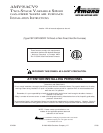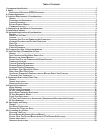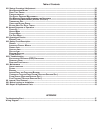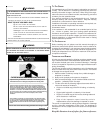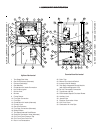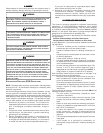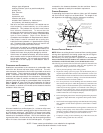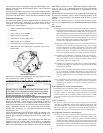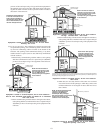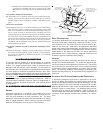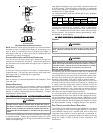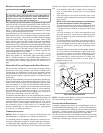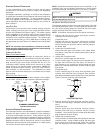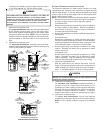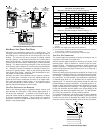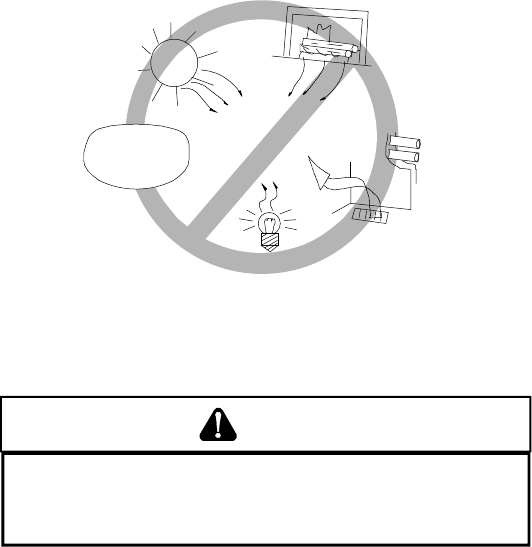
9
ANSI Z223.1 (Section 5.3), or CSA B149 Installation Codes (Sec-
tions 7.2, 7.3, or 7.4), or applicable provisions of the local building
codes for determining the combustion air requirements for the
appliances.
Most homes will require outside air be supplied to the furnace area
by means of ventilation grilles or ducts connecting directly to the
outdoors or spaces open to the outdoors such as attics or crawl
spaces.
The following information on air for combustion and ventilation is repro-
duced from the National Fuel Gas Code NFPA 54/ANSI Z223.1 Section
5.3.
5.3.1 General:
(a) The provisions of 5.3 apply to gas utilization equipment installed in
buildings and which require air for combustion, ventilation and dilu-
tion of flue gases from within the building. They do not apply to (1)
direct vent equipment which is constructed and installed so that all
air combustion is obtained from the outside atmosphere and all flue
gases are discharged to the outside atmosphere, or (2) enclosed
furnaces which incorporate an integral total enclosure and use only
outside air for combustion and dilution of flue gases.
(b) Equipment shall be installed in a location in which the facilities for
ventilation permit satisfactory combustion of gas, proper venting
and the maintenance of ambient temperature at safe limits under
normal conditions of use. Equipment shall be located so as not to
interfere with proper circulation of air. When normal infiltration
does not provide the necessary air, outside air shall be introduced.
(c) In addition to air needed for combustion, process air shall be pro-
vided as required for: cooling of equipment or material, controlling
dew point, heating, drying, oxidation or dilution, safety exhaust,
odor control, and air for compressors.
(d) In addition to air needed for combustion, air shall be supplied for
ventilation, including all air required for comfort and proper working
conditions for personnel.
(e) While all forms of building construction cannot be covered in detail,
air for combustion, ventilation and dilution of flue gases for gas
utilization equipment vented by natural draft normally may be ob-
tained by application of one of the methods covered in 5.3.3 and
5.3.4.
(f) Air requirements for the operation of exhaust fans, kitchen ventila-
tion systems, clothes dryers, and fireplaces shall be considered in
determining the adequacy of a space to provide combustion air
requirements.
5.3.2 Equipment Located in Unconfined Spaces:
In unconfined spaces (see definition below) in buildings, infiltration may
be adequate to provide air for combustion ventilation and dilution of
flue gases. However, in buildings of tight construction (for example,
weather stripping, heavily insulated, caulked, vapor barrier, etc.), addi-
tional air may need to be provided using the methods described in 5.3.3-
b or 5.3.4.
Space, Unconfined.
For purposes of this Code, a space whose volume is not less than 50
cubic feet per 1,000 BTU per hour of the aggregate input rating of all
appliances installed in that space. Rooms communicating directly with
the space in which the appliances are installed through openings not
furnished with doors, are considered a part of the unconfined space.
5.3.3 Equipment Located in Confined Spaces:
(a) All Air from Inside the Building: The confined space shall be pro-
vided with two permanent openings communicating directly with
an additional room(s) of sufficient volume so that the combined
volume of all spaces meets the criteria for an unconfined space. The
total input of all gas utilization equipment installed in the combined
space shall be considered in making this determination. Each open-
ing shall have a minimum free area of 1 square inch per 1,000 BTU
Corrections must be in accordance with the latest edition of the
National Fuel Gas Code NFPA 54/ANSI Z223.1 and/or CSA B149
Installation Codes.
If resizing is required on any portion of the venting system, use the
appropriate table in Appendix G in the latest edition of the National
Fuel Gas Code ANSI Z223.1 and/or CSA B149 Installation Codes.
THERMOSTAT L OCATION
The thermostat should be placed approximately five feet fom the
floor on a vibration-free, inside wall in an area having good air
circulation. Do not install the thermostat where it may be influ-
enced by any of the following:
• Drafts, or dead spots behind doors, in corners, or under
cabinets.
• Hot or cold air from registers.
• Radiant heat from the sun.
• Light fixtures or other appliances.
• Radiant heat from a fireplace.
• Concealed hot or cold water pipes, or chimneys.
• Unconditioned areas behind the thermostat, such as an
outside wall.
HOT
COLD
DRAFTS OR DEAD SPOTS
-BEHIND DOORS
-IN CORNERS
-UNDER CABINETS
Thermostat Influences
Consult the instructions packaged with the thermostat for mount-
ing instructions and further precautions.
VV
VV
V
. CO. CO
. CO. CO
. CO
MBUSTIMBUSTI
MBUSTIMBUSTI
MBUSTI
OO
OO
O
N & VENTILN & VENTIL
N & VENTILN & VENTIL
N & VENTIL
AA
AA
A
TITI
TITI
TI
OO
OO
O
N AIR REQUIREMENTSN AIR REQUIREMENTS
N AIR REQUIREMENTSN AIR REQUIREMENTS
N AIR REQUIREMENTS
WARNING
P
OSSIBLE PROPERTY DAMAGE, PERSONAL INJURY OR DEATH MAY OCCUR
IF THE FURNACE IS NOT PROVIDED WITH ENOUGH FRESH AIR FOR PROPER
COMBUSTION AND VENTILATION OF FLUE GASES. MOST HOMES REQUIRE
OUTSIDE AIR BE SUPPLIED TO THE FURNACE AREA.
Improved construction and additional insulation in buildings have
reduced heat loss by reducing air infiltration and escape around
doors and windows. These changes have helped in reducing
heating/cooling costs but have created a problem supplying com-
bustion and ventilation air for gas fired and other fuel burning appli-
ances. Appliances that pull air out of the house (clothes dryers,
exhaust fans, fireplaces, etc.) increase the problem by starving
appliances for air.
House depressurization can cause back drafting or improper com-
bustion of gas-fired appliances, thereby exposing building occu-
pants to gas combustion products that could include carbon mon-
oxide.
If this furnace is to be installed in the same space with other gas
appliances, such as a water heater, ensure there is an adequate
supply of combustion and ventilation air for the other appliances.
Refer to the latest edition of the National Fuel Gas Code NFPA 54/



